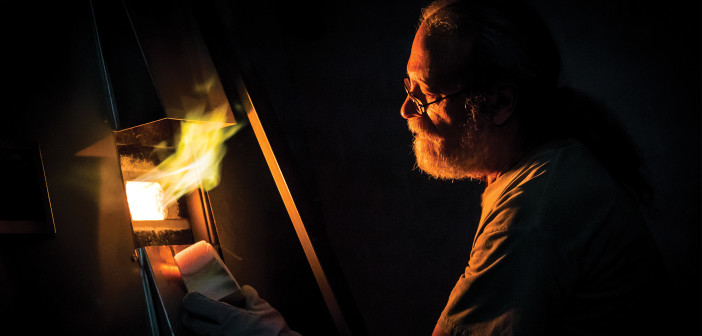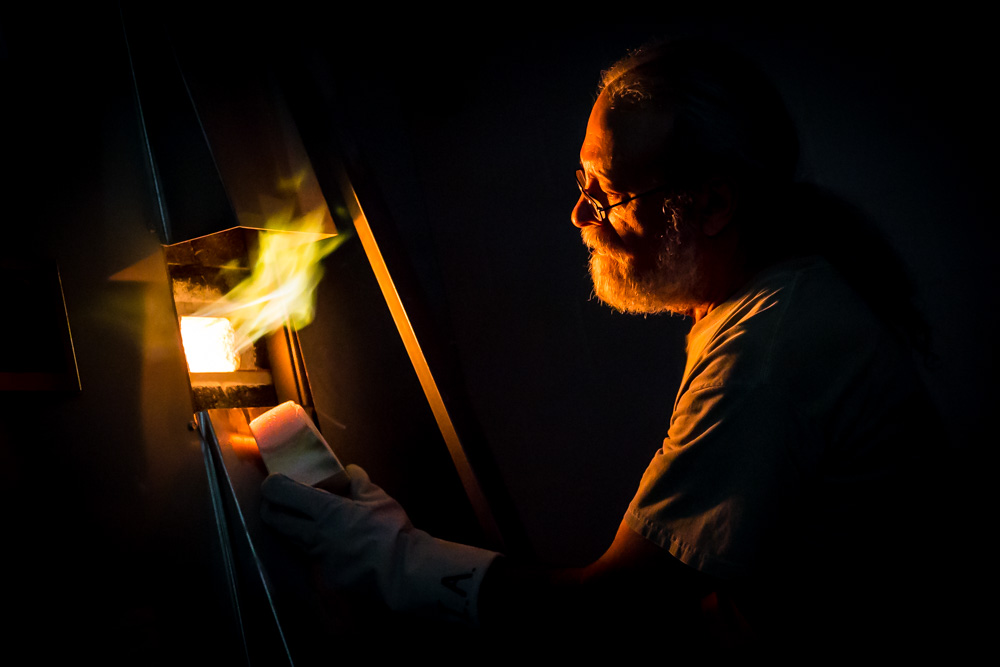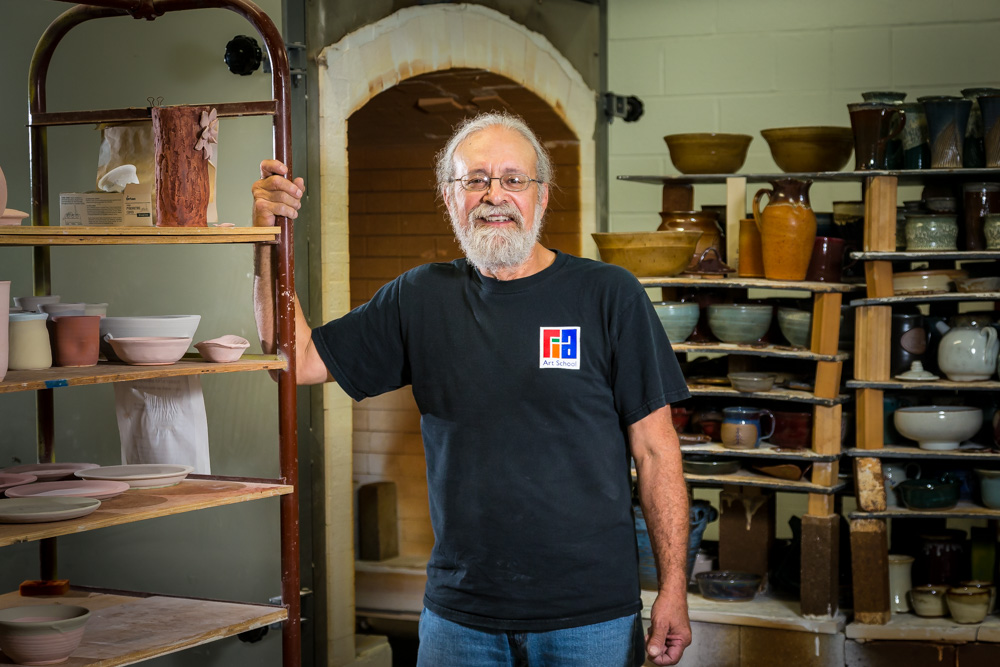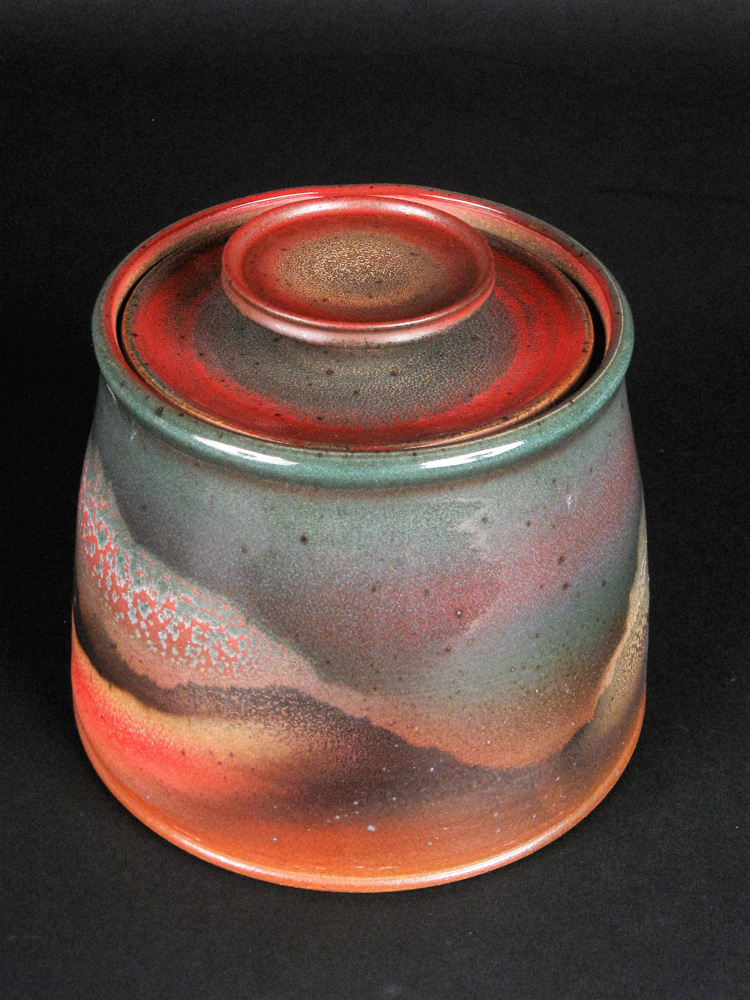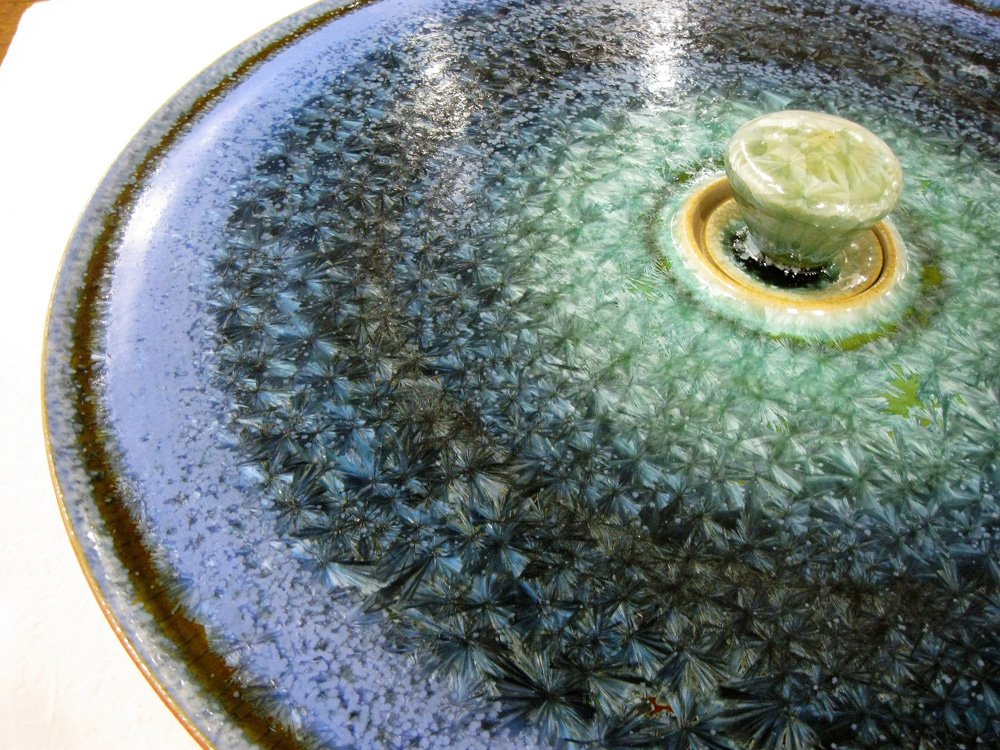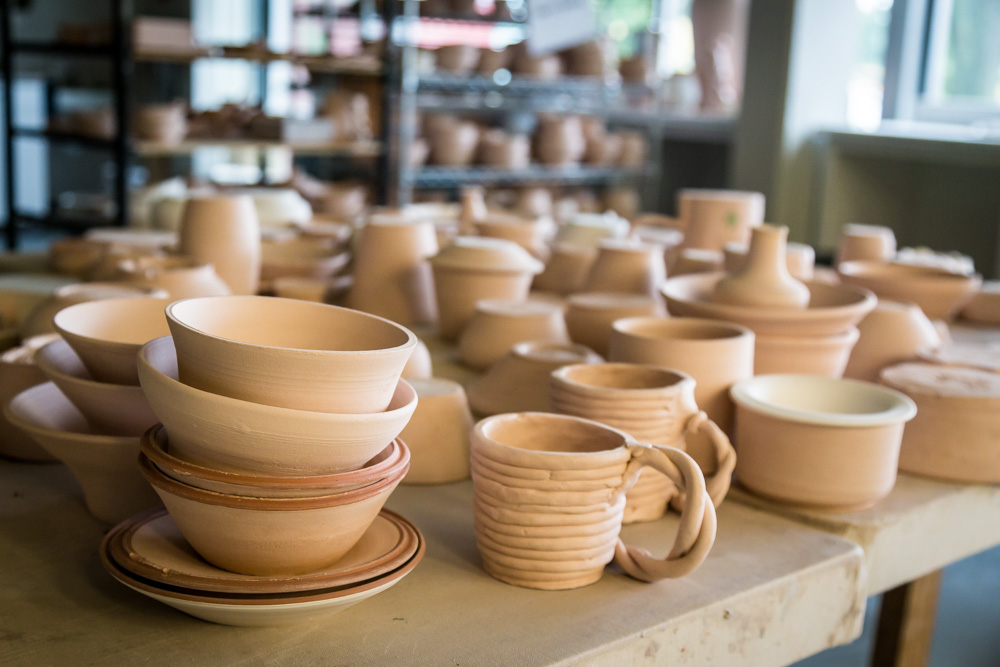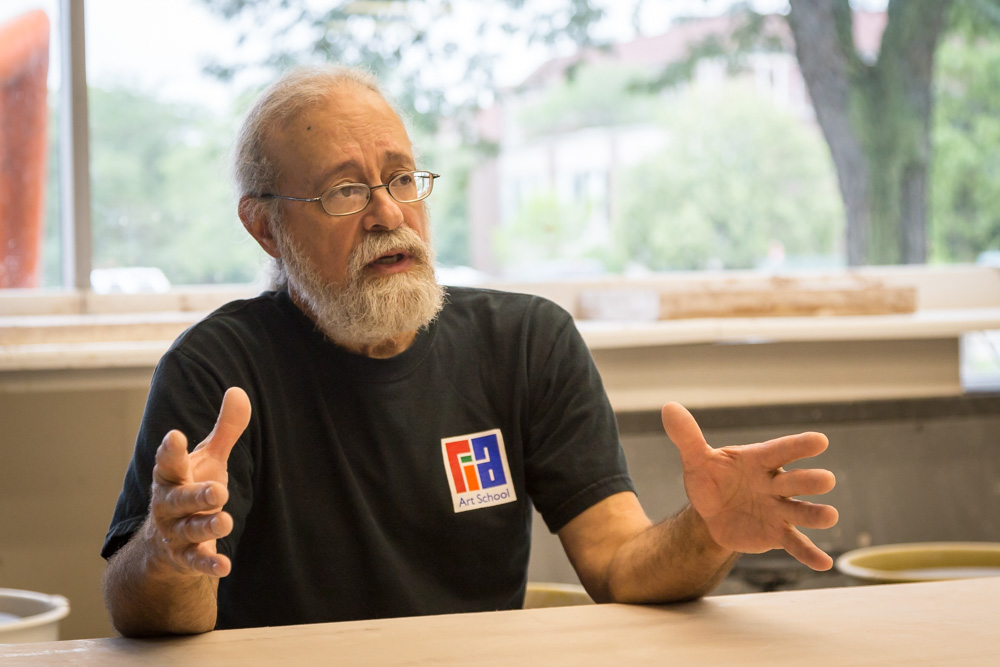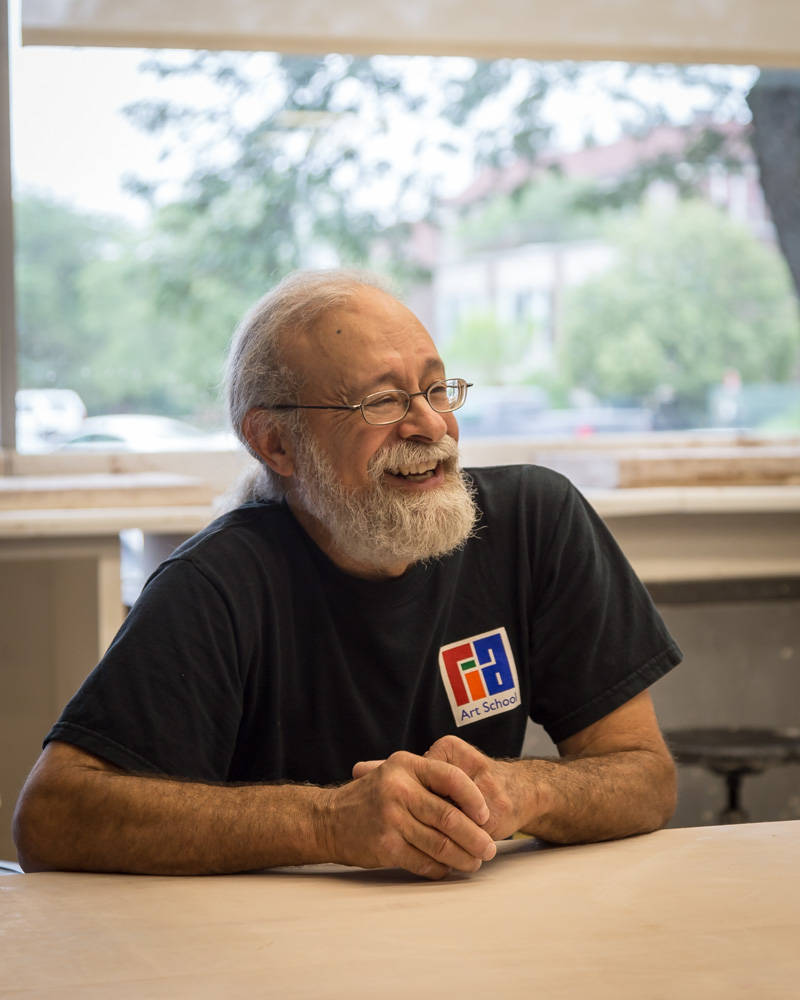Guy Adamec started out at Knox College in Illinois as a pre-med/chemistry major. When he was invited by a fellow musician and dormmate to watch him throw clay pots, Adamec tried working with clay – and never looked back. His parents might have worried a bit about his decision not to pursue medicine and become an artist, “but, when they saw that you can be successful in any field, and when I got into Cranbrook Academy of Art for my master’s, they weren’t as concerned,” he recalls.
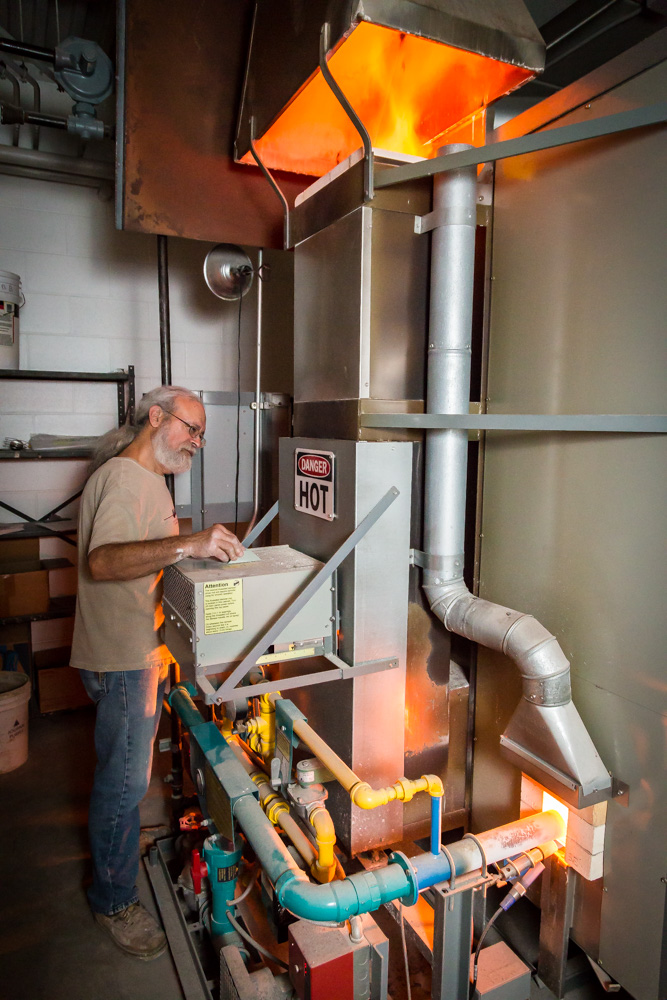 Attending Cranbrook was Adamec’s first stay in Michigan. In 1976, he was offered the position of fire master by Flint Community Schools, which put him in charge of firing the kiln for all of the clay work. Now, he fires many kilns once a week for student work at the Flint Institute of Arts Art School – each kiln load is a three-day process—involving about 25 tons of clay each year. He has been fire master for over 40 years, 27 with Flint Schools and 15 more after it changed hands to the Cultural Center and the FIA took over the building. When he moved to Flint in the 70s, he wasn’t familiar with the city, but says, “it was booming and the Community Education program was a model for the nation. People came here from around the country to see how local schools were used for continuing education – this was famous. And I was part of that – I was proud of it.”
Attending Cranbrook was Adamec’s first stay in Michigan. In 1976, he was offered the position of fire master by Flint Community Schools, which put him in charge of firing the kiln for all of the clay work. Now, he fires many kilns once a week for student work at the Flint Institute of Arts Art School – each kiln load is a three-day process—involving about 25 tons of clay each year. He has been fire master for over 40 years, 27 with Flint Schools and 15 more after it changed hands to the Cultural Center and the FIA took over the building. When he moved to Flint in the 70s, he wasn’t familiar with the city, but says, “it was booming and the Community Education program was a model for the nation. People came here from around the country to see how local schools were used for continuing education – this was famous. And I was part of that – I was proud of it.”
According to Adamec, the success of Flint’s art programs is largely due to the nature of the community. “You move to a place like Flint with the auto industry – these are skilled tradespeople who make things,” he says. “They go to work and make things; but they are making what other people tell them to make. They come to a place like FIA, and they can make whatever they want. I have many current and retired auto workers in class who are used to making things, and they enjoy creating for their own personal satisfaction.”
Over the years, Adamec has worked with four directors at FIA and a lot has changed, “but they have been very supportive and every few years, there is an expansion … and they are adding again!” he exclaims. “The place keeps growing and they accommodate the need, which is really quite remarkable for the size of the city; the Cultural Center is outstanding. It’s a gem I’m happy to be a part of.”
Philosophy & Inspiration
Adamec believes that the key to an artist’s success is, “having confidence in one’s own ability, and then, making it unique. It’s about doing your own thing and doing it well, and people will find you.”
The greatest influence on his work springs from his first pottery instructor’s philosophy of clay, which involved “an attitude, a confidence, centering yourself before you center the clay, and a strong focus on traditional, functional pottery.” Adamec is drawn to the challenge of making functional pottery – things that someone can use – and then “to be personally expressive within the confines of a functional pot … that’s difficult to do,” he stresses.
Another aspect of his clay philosophy is embracing imperfections in a piece that are often viewed as flaws. “We are so accustomed to machine-made objects in our society, that we see variations as flaws, when in reality, the variations say something about the person who made it, and that makes them exceptional,” he shares.
Adamec’s work is inspired by forms in nature, “the changing of the seasons in Michigan, watching the shapes of snow, looking at rocks,” and also by images of nebulae from outer space, trying to duplicate those surfaces on his pots. Mountain climbing was inspirational, as well. “Standing on top of a mountain and seeing 200 miles in every direction is a spiritual experience, because you realize how small
and insignificant you are compared to things like geologic time, and that puts it all into perspective,” he says. Adamec also is inspired by quality craftsmanship. “I look at things that are well-made. I don’t consider myself just a potter; my title is fire master, but I would prefer just ‘maker.’ I do public artwork, my wife and I built our house and cabin, I’ve helped build homes for other people. It’s all the same attitude as making a pot – it’s just bigger and takes longer. But, you have to take your time and do it right.”
The Process
When Adamec begins working with clay, it is usually at the pottery wheel. He explains, “after you make your piece, it has to go through a drying process. When dried completely, the clay is called greenware, and is then typically put into an electric kiln to be fired.” Greenware that has been fired is called bisqueware, and it is porous and strong enough to apply the glaze without destroying it. “So, the glazing process begins,” Adamec continues, “a layer of glass is melted over the piece. Once the glaze is applied, then it is fired again, and you have options for firing at different temperatures.” Most of the work created at FIA will be fired at what is called high fire – about 2,350°F – which makes a piece food-safe and functional.
His chemistry background heightens Adamec’s ability to create unique glazes. He teaches a Glaze Chemistry class at the FIA and most of the glazes used at the Art School are unique to the program. “I take pride in that,” he shares. “We have some glazes that students have made, as well, so there is ‘Linda’s Turquoise’ and Linda Savage created it. This is something very unique we have here.” Adamec layers glazes and often fires a piece more than once – some will have seven different layers in order to create a special effect. He looks at the rocks and nebulae that inspire his work, and challenges himself. “Anything that I can imagine, I can duplicate in a glaze,” he says. “That’s the challenge for me. I’ve been making pots since 1970 and refining the process over and over, getting better and growing.” Even after all of these years, he insists that all of his creations are flawed. “It’s a reflection of the human condition,” he says. “None of them are perfect, but that is part of it – you see the maker.”
Adamec is adamant about the importance of seeing art as a valuable process, not a finished product. According to him, part of the reason that school arts programs get cut is because people focus on the finished product; but, he insists that the focus should be on the value of the creative process. He explains, “it is very important for children to be exposed to art at a young age. We teach them basic technique, and then THEY have to come up with an IDEA and figure out how to get there. Art is problem-solving, it is engineering, a lesson they will take through their entire life, regardless if they are making art or doing something else. Kids come to class here and have a great time, meet new friends and make things.” He stresses, “our mission at the FIA Art School is to expose people to the creative process.”
Community Involvement
Besides his work as fire master, Adamec has been teaching courses at the FIA Art School and says, “just about every place in Flint where one can teach art, I’ve done it.” Plus, he is extremely active in the Flint art community and has a steady flow of commissioned work. “If you stay in one area for a while, people get to know you and just ask for something, so I usually have a month or two of work ahead of me.” He shows his work in galleries around the state, including a show every other year at Buckham Gallery, an important place to him. “I wasn’t a founding member at Buckham, because I was building my house when they started it, but I joined soon after,” he says. “Buckham is a unique gallery – it’s art that you wouldn’t see other places, more emerging artists, art on the cutting edge, which is essential in a community like Flint.”
One of the ways Adamec gives back to the community is through the Empty Bowls project with the Food Bank of Eastern Michigan. Empty Bowls is an international grassroots effort to raise money and awareness of the fight to end hunger. The program began in 1990 in Bloomfield Hills, and Adamec brought it to Flint in 1992. That first year, he made a few hundred bowls for the fundraiser, which were sold at a soup luncheon to help feed the needy in the area. It’s been going strong and expanding ever since. Last year, they made 1,700 bowls and raised enough for 276,000 meals. “This is what I feel Flint is all about,” he says. “It is a remarkably generous community. When I think about why I am here, it is because of the people.”
Adamec also helped begin the Art at the Market Gallery at the Flint Farmers’ Market, and worked with artist, Marcy Yurk, to design and create the mosaic sign for the facility. His community projects include UM-Flint’s 50th Anniversary Rainbow Rock on campus, among others. Community artwork has been a priority to him and he sees it as an honor. “To make a piece which is seen and enjoyed by many and becomes a permanent local landmark is, for me, reaching one of the ultimate goals,” he states.
Looking ahead, Adamec is excited about the most recent expansion at the FIA Art School that will accommodate a state-of-the-art glass-blowing studio and a foundry for casting bronze sculptures. “Next year, there will be a dedicated sculpture studio, and the glass-blowing studio will have a seating area where people can watch demonstrations and then take a class to learn how to do it,” he states. Adamec feels that with all of the expansion happening, there is no reason for him to retire. “I have been here a long time, but now we’ve got all these cool new toys to play with. Why would I stop now? I am not a person who sits around – I’m making something.”
For more information on Guy Adamec, or to contact him about commissions, visit guyadamec.com.
Photography by Eric Dutro ♦ photos provided by Guy Adamec
Petratrollgrafik / Shutterstock.com

